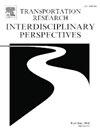Development of path reservation for wheelchair users within a High-Activity train Station: A case study of SRT Red Line, Don Mueang Station, Bangkok, Thailand
IF 3.9
Q2 TRANSPORTATION
Transportation Research Interdisciplinary Perspectives
Pub Date : 2025-01-01
DOI:10.1016/j.trip.2024.101313
引用次数: 0
Abstract
This study investigates the impact of spatial-based accessibility on the SRT Red Line, Don Mueang Station, a railway station that frequently poses challenges for wheelchair users and has recently been developed under the megaproject “The High-Speed Railway Connecting Three Airports Project”. Through comprehensive approaches, including the Graph Theory (Betweenness) in Urban Network Analysis (UNA) and path reservation based on principles of station accessibility, this study explores the relationship between congestion probability (Betweenness) in detailed origins and destinations, as well as kinematics for wheelchair users. The findings analyse the implication and effectiveness of inclusively reserved route design to facilitate movement and provide more efficient mobility for the target study group with safety. By examining the passenger volume of the station during the peak hour, this study provides valuable insights into the understanding and analysis of congestion possibility’s impact on the kinematics for wheelchair users. The results contribute to the existing knowledge by giving an in-depth comprehension of the role of path reservation based on spatial-based accessibility and legal standards and regulations in improving circulation within the station. This study enhances the understanding of the effects of spatial-based accessibility on the inclusive path reservation design and provides implications for future application and research in the field of station accessibility.
求助全文
约1分钟内获得全文
求助全文
来源期刊

Transportation Research Interdisciplinary Perspectives
Engineering-Automotive Engineering
CiteScore
12.90
自引率
0.00%
发文量
185
审稿时长
22 weeks
 求助内容:
求助内容: 应助结果提醒方式:
应助结果提醒方式:


